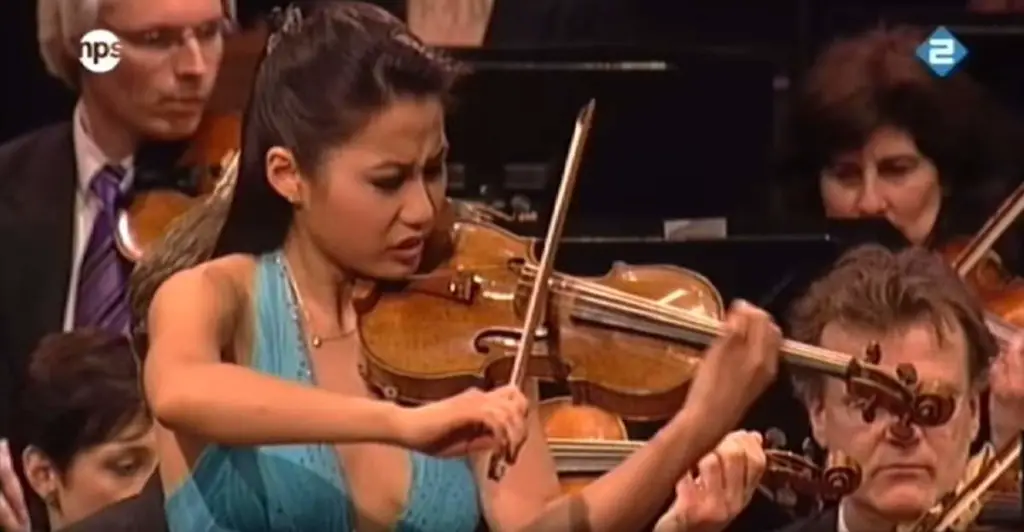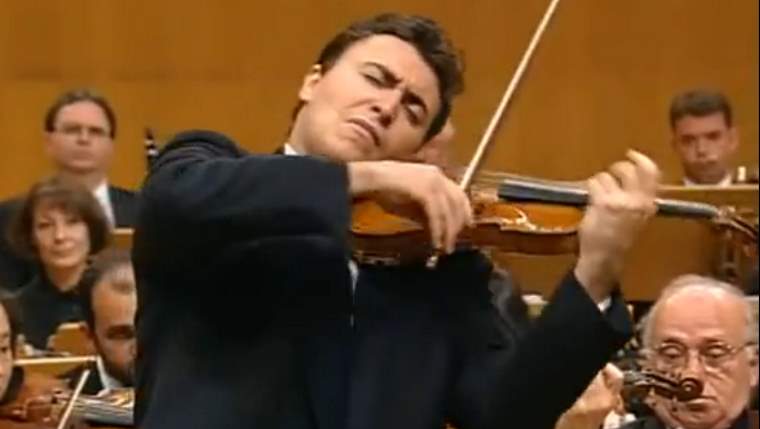Accompanied by the Radio Filharmonisch Orkest (Netherlands Radio Philharmonic Orchestra), the American classical violinist of Korean origin, Sarah Chang plays Jean Sibelius’ Violin Concerto in D minor, Op. 47. Conductor: Jaap van Zweden.
Jean Sibelius’ Violin Concerto
Jean Sibelius’ Violin Concerto, composed in 1904, stands as a shining testament to the Romantic era’s emotive power, blending virtuosic demands with profound musical depth. Written during a period when Sibelius was grappling with inner demons and the desire to establish a national musical identity for Finland, this concerto captures a rich tapestry of emotions and landscapes.
It’s worth noting that the concerto we commonly hear today underwent revisions. Sibelius initially premiered an earlier version in 1904, but after receiving mixed reviews, notably due to its demanding violin part and its perceived lack of coherence, he revised it in 1905. The final version, which premiered in 1905, was streamlined in its orchestration and violin parts, though it retained the deep, introspective qualities of the original.
The concerto is characterized by its fusion of virtuosic elements and a profound sense of lyricism. While it offers a rigorous challenge for the soloist, showcasing rapid arpeggios, intricate double stops, and sweeping melodic lines, it’s not just a display of technical prowess. Beneath the surface lies a deep musical narrative, echoing the vast landscapes of Sibelius’ native Finland and reflecting his own personal struggles and aspirations.
One of the unique aspects of this concerto is Sibelius’ treatment of the orchestra and solo violin. Rather than positioning them as opposing forces or distinct voices, Sibelius weaves them together into an integrated musical fabric. The solo violin often emerges from the orchestra’s textures, creating a seamless ebb and flow between the individual and the collective.
With its captivating blend of virtuosity and depth, Sibelius’ Violin Concerto has secured its place as one of the most revered pieces in the violin repertoire, celebrated for its ability to transport both performers and audiences into a world of profound emotion and beauty.
Movements:
- Allegro moderato (with many tempo changes throughout) in D minor, in 2/2 mostly, with some sections in 6/4 and 4/4 time
- Adagio di molto in B-flat major and in 4/4 time
- Allegro, ma non tanto in D major and in 3/4 time
1. Allegro moderato
The first movement of Jean Sibelius’ Violin Concerto is marked “Allegro moderato.” It commences with a soft, atmospheric backdrop created by the orchestra, setting a stage that’s both mysterious and evocative. Soon after, the solo violin enters with a haunting, melancholic melody, showcasing the instrument’s lyrical capabilities right from the start. This initial theme is expansive and emotive, encapsulating the vastness and introspective quality reminiscent of Nordic landscapes.
As the movement progresses, contrasting themes are introduced, including sections that allow the soloist to demonstrate virtuosity with rapid arpeggios, quick scalar runs, and intricate double stops. Sibelius brilliantly melds these technical displays with the movement’s overall emotive narrative, ensuring that the virtuosity never feels gratuitous but rather serves the larger musical journey.
The relationship between the orchestra and solo violin in this movement is particularly noteworthy. Instead of a traditional concerto dialogue where the soloist and orchestra might alternate or contrast, they frequently intertwine. The orchestra not only provides support but also augments and expands upon the violin’s themes, creating a rich, integrated soundscape.
Throughout the movement, there’s a palpable tension, a push and pull between moments of passionate fervor and introspective calm. This dynamism keeps the listener engaged, as themes are revisited, transformed, and developed. The culmination of these elements results in a movement that’s both dramatically intense and deeply poetic, capturing the essence of Sibelius’ unique voice and vision.
2. Adagio di molto
The second movement of Sibelius’ Violin Concerto is marked “Adagio di molto.” This movement stands in stark contrast to the fervor of the first, offering listeners a space of profound introspection and lyrical beauty. Its atmosphere is one of serene melancholy, evoking images of vast, tranquil landscapes and deep, reflective waters.
The movement begins with gentle, sweeping strings that establish a sense of calm and spaciousness. The solo violin soon enters, introducing a melody that’s both tender and sorrowful. This theme, with its long, singing lines, allows the soloist to explore the full expressive range of the instrument, drawing out every nuance of emotion. The interaction between the solo violin and orchestra is intimate, with the orchestra often echoing or subtly augmenting the violin’s sentiments.
One of the striking characteristics of this Adagio is its sense of stillness. Even as melodies flow and evolve, there’s a pervasive feeling of time being suspended, as if the music is capturing a moment of deep contemplation. The textures are lush but never overly dense, allowing each phrase to breathe and resonate.
As the movement progresses, there are brief moments of heightened passion and intensity, where the violin soars to its upper registers, and the orchestra swells in response. However, these moments are fleeting and always return to the movement’s prevailing mood of introspective calm.
In its entirety, the second movement of Sibelius’ Violin Concerto is a masterclass in emotional depth and restraint. It serves as a meditative heart of the concerto, allowing both performers and listeners to delve into a realm of profound emotion and beauty.
3. Allegro, ma non tanto
The finale of Jean Sibelius’ Violin Concerto
, marked “Allegro, ma non tanto,” provides a spirited and rhythmic conclusion to the work, contrasting the introspective nature of the previous movement. This finale is characterized by its vivacious energy, brilliant orchestration, and the return of virtuosic elements for the solo violin.
The movement opens with a rhythmic motif introduced by the orchestra, establishing a sense of urgency and momentum from the outset. The solo violin quickly joins the fray with a series of dazzling passages, weaving in and out of the orchestral texture, showcasing its agility and flair.
One of the movement’s notable features is its rhythmic dynamism. Sibelius frequently plays with syncopation and employs a variety of rhythmic patterns, creating an almost dance-like feel at times. This rhythmic vitality keeps the music propulsive and engaging throughout.
Thematically, the movement is rich with contrasting ideas. While the primary themes are lively and assertive, Sibelius intersperses moments of lyrical beauty, where the violin sings out with expansive melodic lines, providing brief respites from the overarching vigor.
The interplay between the soloist and the orchestra reaches a pinnacle in this movement. They engage in a spirited dialogue, with the orchestra often picking up and developing motifs introduced by the violin. This back-and-forth creates a dynamic and captivating musical conversation.
As the movement drives towards its conclusion, the energy and tension build. The violin’s virtuosic displays become even more pronounced, culminating in a series of brilliant passages that push the soloist’s technical and expressive boundaries. Ultimately, the movement concludes with a sense of triumph and exhilaration, providing a fitting end to a concerto that traverses such a vast emotional landscape.
Sarah Chang

Sarah Chang (born Young Joo Chang, on December 10, 1980) is an American classical violinist. She is the daughter of Myoung-Jun, a composer, and Min-Soo Chang, who was a violinist and music teacher.
Chang’s parents moved to the United States from South Korea in 1979 for her father’s advanced music degree at Temple University. Recognized as a child prodigy, she first played as a soloist with the New York Philharmonic and the Philadelphia Orchestra in 1989. She enrolled at Juilliard School to study music, graduated in 1999, and continued university studies. Especially during the 1990s and 2000s, Chang had major roles as a soloist with many of the world’s major orchestras.
Chang plays the 1717 Guarneri del Gesù violin, which she received through the late Isaac Stern, and uses a variety of bows: she has said that she prefers a Pajeot for Mozart and Bach; a Sartory for the Tchaikovsky and Sibelius concertos; and two Dominique Peccattes for other music.
Sources
- Sarah Chang on Wikipedia
- Violin Concerto (Sibelius) on Wikipedia


![Sibelius: Violin Concerto [Hilary Hahn]](https://cdn-0.andantemoderato.com/wp-content/uploads/2022/09/Sibelius-Violin-Concerto-Hilary-Hahn-2010-1024x565.jpg)


